Thick descriptions
The Visibility of Animals in Zoos
By Melissa Geerars.
According to John Berger, zoos “cannot but disappoint” (28). In the zoo, each animal is framed by a cage, and the visitor goes from cage to cage, like visitors in an art gallery. However, every time, the visitor is disappointed, because often they are just lying around, or even out of sight, living their own life. The animals in the zoo are nothing like they are on television or in the wild. (23-4). Real animals have disappeared, and now we live without them (11). Zoos are nothing more than a monument to the animal’s disappearance (26). Jonathan Burt, an animal studies scholar, does not fully agree with Berger, because according to him, Berger oversimplifies the historical claims he makes (203). It is not the animal itself that disappears, it is the death of the animal that disappears from our view, because from the nineteenth century and onwards, animals “needed to be seen to be treated correctly which was an important and measurable criterion of welfare and an index of what it was to be a visibly civilized society” (213). Therefore, the visual became linked to the moral, and the animal became integral to human history.
Because this visual element is so important to our own history, I want to find out how this works in zoos. For example, do zoos hide the death of animals? And how do zoos make animals (look) content? Zoos have developed over time so that their exhibits look more and more natural, but we can ask ourselves the question for who this development was most important, the animal or the human. In Zoo: A History of Zoological Gardens in the West, Baratay and Hardouin-Fugier note that “[i]n replacing the image of a confined animal with that of one at liberty, the new style presentation at Stellingen appears to have been responding to what may have been an unconscious repulsion against any symbols of captivity at all” (237). Although this quote is about Stellingen zoo, it might have been about any zoo that has developed their exhibits to make them look more natural. However, my hypothesis is that this feeling of repulsion is not the same for all animals. Ursula Heise, in her book Imagining Extinction, describes how the species that are usually selected to bring extinction under the attention of people belong to a narrow set. They are often large mammals or beautiful birds, while animals such as fish or reptiles are ignored. These ‘flagship species’ attract attention from the public and are good tools to raise awareness and funds (23). Of course, this does not only work for anyone who wants to raise awareness for extinction, but also for zoos. Therefore, more specifically, I want to look at the difference between the visibility of flagship species and other animals. To do this, I have chosen to investigate one specific zoo, namely Diergaarde Blijdorp in Rotterdam. In their policy plan, it is stated that Blijdorp aims to show a wide variety of animals in order to demonstrate the biodiversity on earth (“Beleidsplan”). Therefore, I expect this zoo to have many species of animals, including non-flagship species. In addition, Diergaarde Blijdorp is one of the oldest zoos in the Netherlands, which means I expect to be able to see the development over time. To collect the information needed to answer the research question, I mainly observed. By walking around and observing every detail, one can learn a lot. I looked not only at the exhibits to find the things ‘normal’ visitors are or are not interested in, but I also observed the visitors and read the signs. Apart from observing the zoo and its information signs, I explored the website, other social media, and the items you get at the zoo, such as the entry ticket and the map. I will start by providing a short introduction to the site, and then move on to the description, in which I will focus on the exhibits, on the holding spaces and on the visibility of animals in the media Diergaarde Blijdorp uses.
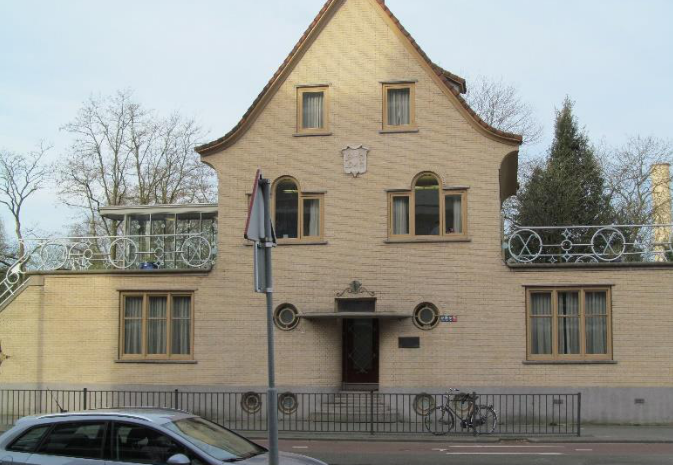
Old entrance building (1940) of Diergaarde Blijdorp, which clearly shows van Ravesteyns graceful lines. The entrance is to the right of the building. Photo by Lauren.
A Short History of Diergaarde Blijdorp
‘De Rotterdamsche Diergaarde’ was founded in 1857, with the first director, Henri Martin, originally being a lion tamer. The zoo started as a small place, but slowly, the zoo expanded. Several new exhibits, such as a monkey house, a building for predators, and a birdhouse were built. However, in 1937, the city of Rotterdam decided the zoo had to move from the city centre to make room for urban development. For the design of the zoo, the architect Sybold van Ravesteyn was chosen (“Organisatie”). His plans were progressive, because he did not follow the trend of ‘new functionality’. Instead, he used graceful lines, ornaments and art. According to him, a building should not only be functional, but also aesthetic (“Monumenten”). In 1940, the new zoo was officially opened. In it, one could clearly see the influences of for example Carl Hagenbeck. Van Ravesteyn made sure to create large exhibits and to use moats instead of bars. Despite this, as Blijdorp states on their website, architecture was more important to van Ravesteyn than the wellbeing of the animals (“Monumenten”).
Now, the exhibits have improved a lot with regards to the animals. In the Blijdorp of the present, animal well-being comes first (“Monumenten”). They call themselves one of the most modern zoos of Europe, with their animals living in exhibits that are as natural as possible, which also means that often several species share their space with others. In addition to being ‘just’ an attraction, the zoo focuses on education and conservation. They educate school children and other visitors about nature and how humans can help to conserve it. To be able to do this, they aim to show a wide variety of animals, in order to make visitors aware of the biodiversity on earth, with the hope that these visitors will themselves do something to help preserve the earth. In addition, the zoo itself acts to conserve nature. For example, they coordinate several breeding programs, such as that of the red panda and the Asian elephant. Moreover, they facilitate applied scientific research (“Beleidsplan”).
Although Blijdorp has many animals and several functions, the zoo is a non-profit foundation. All money they receive is used to keep the zoo running and to aid the conservation of nature. In their policy plan, they describe how they have a ‘masterplan’. This means that at all times two big projects are being realised, either a whole new plan, or renovation. In the next years (the years since the policy plan was published, which is 2013) Blijdorp wants to modernise and renovate the monuments they have. These projects are funded by individuals, funds, or foundations. To be able to get money from funds and foundations, the plans need to be attractive. When one thinks about the zoo, animals such as lions, tigers, elephants, and bears will probably immediately come to mind, the animals that Ursula Heise has called flagship species. These are also probably the kind of animals that will ‘earn’ the most money. This is again a reason that my hypothesis is that different kind of animals are shown in different ways.
The Visibility of Animals in Diergaarde Blijdorp
In the next part, I will focus on three forms of visibility. First, I will focus on the exhibits themselves. Are those of the flagship species in any way different that those of other animals? Next, I will look at the visibility of holding areas in Blijdorp. Lastly, I will look at the visibility of animals in the media Blijdorp uses.
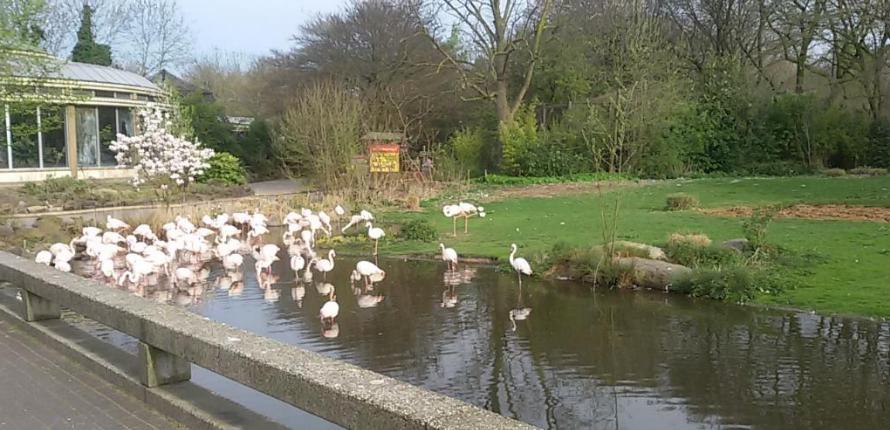
The view to the right of the original entrance.
Coming in via the original entrance, one first sees a pond with flamingos and some eiders. As can be seen in the picture, there are no real bars, only a low concrete fence, which is probably placed there so that children do not fall in the water. Walking past them and going to the right brings the visitor to ‘Asia’, one of the seven areas in Blijdorp.1 The first animal when in ‘Asia’, is the great grey owl, which is easily missed, because it is in a small cage behind some bushes and not on the map. This is a clear difference with the flamingos and eiders one sees at the entrance. Even though both are birds, the flamingos are more colourful and therefore more easy to ‘notice’ anyway. They immediately give the visitor something to look at. On the contrary, the owls are difficult to see even if they were not hidden behind bushes on the path, and therefore probably deemed less interesting.
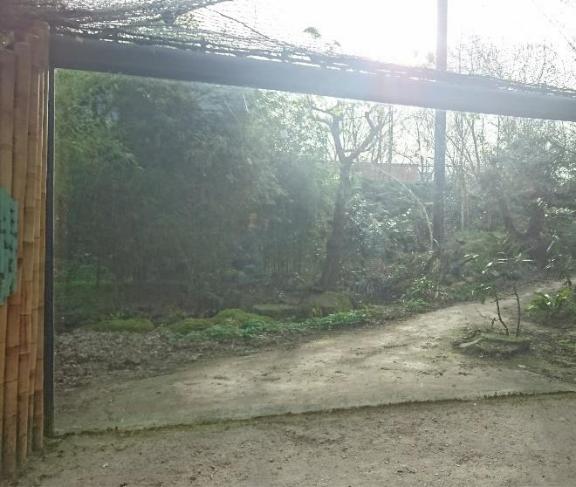
The glass wall dividing the visitor from the leopard. Photo by Leonie.
Soon after the owls, one finds the amur leopard. The leopard is in a cage which does have bars and there is a glass wall so that visitors can see it when it lies there. Here, one can see how important architecture is for visibility. Apart from the bars, the exhibit is made to look natural. There are many trees and bushes, and there is also a cave. In short, all exhibits are made to look natural. In Zooland: The Institution of Captivity, Braverman calls this naturalization, which is “producing nature and obscuring its production” (25). In this way, the zoo erodes the boundaries between nature and artifact. Consequently, the zoo does not only represent nature, it pretends it is nature (36). Carl Hagenbeck, described in the introduction as an inspiration for van Ravesteyn, was one of the first to apply naturalization. However, sometimes making an exhibit look more natural is clearly done in favour of the visitor instead of the animals, because sometimes this was done by painting the walls with tree figures or for example blue sky, which can be seen in the picture on the left, in the exhibit of the komodo dragon. It was even more obvious in the indoor cage of the lion-taled macaque. This cage only had some fake trees to climb, sand on the bottom, and walls painted with tree figures. Although one can never know for certain, the animals un such cages probably do not care about the painted walls, since this is not real nature. However, when it is done well, it might give the visitor a more satisfied feeling.
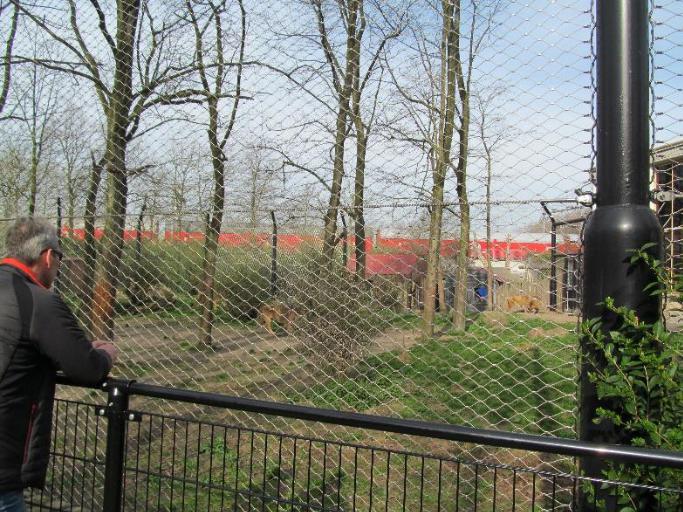
The lion exhibit. Photo by Lauren.
While one would expect the same sort of exhibits for flagship species, there is a clear difference between the lion cage and that of the tiger. Of course, they need different environments, but the spatiality is clearly different. For example, the tiger cage is very far down. To see it, one has to stand behind a rock wall, in front of which is another wire. Behind the rocks are high bars, and some meters down is the tiger. In this way, the tiger is clearly framed by its cage, as Berger suggests, and often it is invisible, because it is lying somewhere behind bushes. The lions on the other hand, are behind bars, in front of which is a fence so visitors cannot reach the bars. They are only slightly lower than the visitors, and have much less foliage in their cage, so they cannot hide behind it like the tigers can. Although this might be my subjective opinion, as a consequence of the difference in spatiality, the tiger exhibit looks much more natural, while one would expect them to feel about the same.
Lastly, regarding exhibits, I want to focus on the ones that are not present in Diergaarde Blijdorp. My hypothesis was that Blijdorp focuses more on flagship species than on other animals, because they ‘earn’ the zoo more money, which it needs, because Blijdorp is a non-profit organisation. While Blijdorp used to organize a yearly ‘insect weekend,’ I could not find any information on and believe this was cancelled after 2012. In addition, while many insects used to be in the Rivièrahal, they were now gone. During my visit to the zoo, I have only seen grasshoppers, although I cannot be sure I might have just missed the other insects. However, when one tries to use the search term ‘insects’ on their website, no pages come up. Also, most flagship species have signs with information about the animals, some larger than others. However, animals such as fish often only had signs with their names on them. In short, there was a clear focus on flagship species, even though Blijdorp’s policy plan states they want to show the biodiversity on earth.
Next, I will focus on the visibility of holding areas in Blijdorp. These are “explicitly artificial, functional, cage-style” areas where animals are kept away from public view (Braverman 72). I think it is important to explore them, because although they are meant to be invisible to the visitor, they are an important part of the zoo. In Blijdorp there is a difference between the visibility of holding areas of bigger and smaller animals. Because the holding areas for bigger animals simply need to be bigger, they are often more visible. For example, for the pigs, monkeys, and even birds, one can guess where the holding spaces are by looking around. However, the holding spaces for the reptiles, and generally the smaller animals that are inside anyway are not easily visible. Yet, they must have holding spaces, because in the exhibit of the crocodile tegu there was a notice telling the visitor it was hibernating behind the scenes.
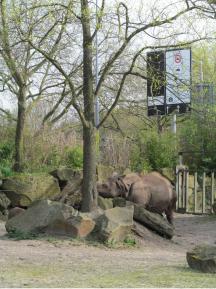
Rhinoceros exhibit. Photo by Lauren.
An example of the visibility of holding spaces is the rhinoceros exhibit. While an effort has been made to make the exhibit look natural, not much effort has been made to hide the gates through which the zoo keepers can come in and behind which the holding space probably is. In addition, as can be seen in the picture on the left, the immersion is not complete, because in the background one can see a very large traffic sign, but this is just one of the downsides of a zoo in the city centre. In general, although the holding spaces are not supposed to be visible for visitors (which is obvious from the doors that can close, little gates in front of them, and the lack of signs), not too much effort is put into making them invisible. Here, we should make a difference between indoor cages, which are often meant to be visible, and actual holding areas. The indoor cages—for example where some animals sleep, or where they are when it is too cold outside—are made into exhibits. They often have nicely painted walls, and they are on the route the visitor has to walk. However, here, one can see a clear contrast between newly renovated indoor cages, and old ones. For example, the okapi cage was recently renovated and made to look good for both the visitor and the animal (meaning it did not only have painted walls, but also actual living nature inside). On the contrary, the gorilla cage is very old and this was also noticed by a child looking at it, who said to his mother: “Het lijkt een gevangenis!” (translation: It looks like a prison!) The holding areas, on the other hand, are not supposed to be seen by visitors, and often visitors will walk right past them.
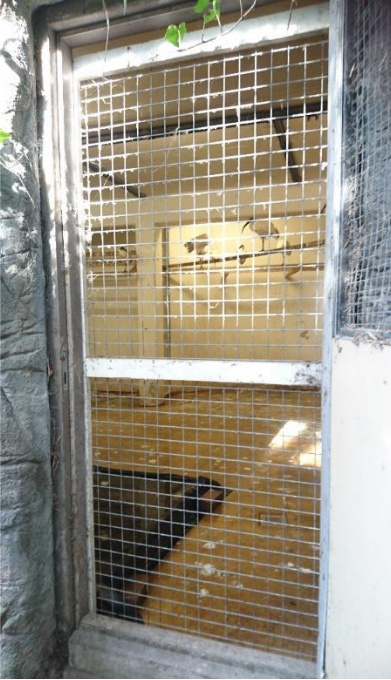
Holding space. Photo by Leonie.
However, when one pays attention to them, they are sometimes visible. Often, doors are left ajar, and one can peek inside. In these places, no effort has been made to make it look more attractive, as can be seen in the picture above. In this picture there is no sign of nicely painted walls, and the birds’ excretion can be clearly seen on the floor. A last point regarding non-exhibit spaces, regards the surgery. As Matthew Chrulew makes clear in “Managing Love and Death at the Zoo,” every aspect of animal life is managed in the zoo. Of course, sometimes animals die in the zoo, and sometimes the zoo might want to save an animal by performing surgery. Jonathan Burt, mentioned in the introduction, would likely argue that this aspect will not be shown in the zoo, because it involves animal death. Interestingly though, Blijdorp has a surgery which visitors can go to, which is even on the map, albeit as a small sign. In front of the surgery, which is behind glass, information is given on for example animal anatomy and death, including a note on how section is done on every animal that dies in Blijdorp. The surgery can also be seen when in practice, however, there is also a curtain that can be pulled down, which implies not every surgery can be seen. I can imagine that sections will not be shown, and following Jonathan Burt, maybe only simple operations that are very likely to succeed will be public. However, this is speculation on my side.

The surgery. Photo by me.
Lastly, when one looks at the focus of the media, it is clear that this is on flagship species, on the big and impressive animals such as Bokito, the polar bears, or the rhinoceroses. On Diergaarde Blijdorp’s Instagram, for example, there are only a few photos of animals that are often deemed less spectacular. In addition, on the website of Blijdorp there is also a focus on the big and spectacular animals. For example, there are ‘animal and plant dossiers’ from which children can learn about the animals and plants. Ten of the sixteen are about large mammals. On the map, too, there is a clear focus on the larger animals, mainly Bokito. On one side of the map is the actual map, including pictures of the most important species in the zoo. There are also less well-known animals on it, and animals one does not necessarily associate with the zoo, such as parrots and butterflies. However, they have chosen the most impressive and colourful animals or pictures. On the other side of the map one can find information about for example souvenirs, the app, and the conservation of nature. Apart from the map, at the entrance of Diergaarde Blijdorp, a ticket is given to every visitor once they have paid. On it is a picture of an animal, from on a picture on the back of the map one can see they have animals such as polar bears, elephants, and giraffes. In short, in the media Diergaarde Blijdorp uses there is a clear focus on more attractive animals.
Conclusion
My hypothesis was that there is a difference between the visibility of flagship species and other animals. In Diergaarde Blijdorp, on the one hand this is true, on the other hand this proved not to be true. In the media Blijdorp uses, there is a clear focus on flagship species, such as polar bears, lions, and the gorillas. These are the animals that will ‘earn’ the zoo most money, so these are the ones you see most often. Also, in Diergaarde Blijdorp itself there is a clear focus on flagship species, even though their policy plan states they want to show many species in order to teach the visitor about biodiversity. However, the difference I would expect to see in the cages or exhibits proved not to be there, at least not very clearly. Of course, there are differences between the exhibits, but apart from differences due to natural habitats, there is no clear difference between the exhibits of flagship species and other animals. On the contrary, often, there were also clear differences between the exhibits of flagship species themselves, such between that of the lions and the tigers, which could not be explained by the development over time. The only clear difference is the fact that the location of the holding areas for the larger animals, which are most often flagship species, is often easier to find than that of other animals. However, taking into account that flagship species are often big mammals, this is not a significant difference. In conclusion, although Diergaarde Blijdorp seems to make no difference in the exhibits of their flagship species and other animals, there is a clear focus on flagship species in the zoo and in the media.
Bibliography
Baratay, Eric, and Elisabeth Hardouin-Fugier. Zoo: A History of Zoological Gardens in the West. Reaktion Books, 2004.
“Beleidsplan Diergaarde Blijdorp.” Diergaarde Blijdorp. December 2013. https://www.diergaardeblijdorp.nl/wp-content/uploads/2014/10/Beleidsplan-Diergaarde-Blijdorp-v12-2013.pdf. Accessed 2 April 2017.
Berger, John. “Why Look at Animals?” in On Looking. 1980. Vintage Books, 1992.
Braverman, Irus. Zooland: The Institution of Captivity. Stanford University Press, 2013.
Burt, Jonathan. “John Berger’s ‘Why Look at Animals?’: A Close Reading.” Worldviews, vol. 9, no. 2, pp. 203-218.
“Dieren- en plantendossiers.” Diergaarde Blijdorp. https://www.diergaardeblijdorp.nl/bijzondere-belevenis/kinderen/dieren-en-plantendossiers/. Accessed 8 April 2017.
“Diergaarde Blijdorp.” Instagram. https://www.instagram.com/diergaardeblijdorp/. Accessed 8 April 2017.
Heise, Ursula. Imagining Extinction: The Cultural Meaning of Endangered Species. University of Chicago Press, 2016.
“Monumenten.” Diergaarde Blijdorp. https://www.diergaardeblijdorp.nl/monumenten/. Accessed 2 April 2017.
“Organisatie.” Diergaarde Blijdorp. https://www.diergaardeblijdorp.nl/organisatie/. Accessed 2 April 2017.

